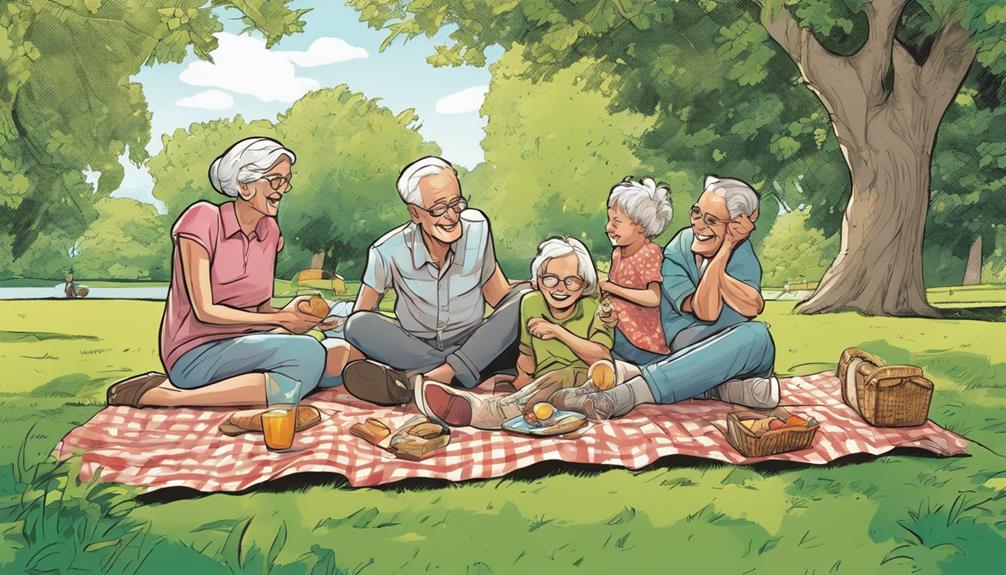Ever wondered how your parents’ home impacts your family? **It’s massive!** Their house isn’t just a building; it’s a treasure trove of memories shaping who you are. Parental living arrangements spotlight generational views. Challenges like multiple generations under one roof need good communication and compromises. Parents nearby offer emotional support and strengthen family ties. Long-distance? You need tech-savvy ways to keep in touch. Choosing parental care options takes careful thought and open conversations. These choices reveal a lot about family relationships.
Key Takeaways
- Parental living arrangements vary from independent to multigenerational.
- Proximity to parents can impact family dynamics and relationships.
- Communication and compromise are crucial in shared living spaces.
- Technology helps bridge the gap in long-distance parental relationships.
- Exploring care options involves evaluating needs, location, and involving parents in decisions.
Family Dynamics and Relationships
In exploring 'Family Ties,' the dynamics and relationships within the Keaton family provide a compelling portrayal of generational differences and familial interactions. The clash of values between parents Steven and Elyse and their children Alex, Mallory, and Jennifer offers a humorous yet insightful look at how different generations perceive the world.
Steven and Elyse, with their liberal views, often find themselves at odds with Alex and Mallory's conservative leanings, creating a rich tapestry of generational conflicts within the family unit. The show skillfully navigates these differences, showcasing the challenges and growth that come from such diverse perspectives under one roof.
The sibling relationships further highlight the generational disparities, with Alex, Mallory, and Jennifer embodying distinct personalities that shape their interactions and viewpoints on various issues. Through their discussions and disagreements, 'Family Ties' explores the complexities of family dynamics, demonstrating how individuals with contrasting beliefs can still coexist and learn from each other.
Home as a Symbol of Belonging

Your family home isn't just a place with four walls – it's a treasure trove of memories, a sanctuary where laughter and tears intertwine, creating a tapestry of shared experiences.
The emotional attachment you feel towards your home isn't just about the physical space; it's about the sense of identity and belonging it provides, grounding you in your roots and shaping who you are.
As you reminisce about the moments spent within those familiar walls, you realize that your family home isn't just a house – it's a living, breathing symbol of love, laughter, and the unique bond that ties you together.
Family Home Memories
Amidst the laughter and tears, the Keaton family home stands as a steadfast symbol of belonging in 'Family Ties'. The walls of the Keaton household echo with family home memories that have shaped the characters' lives. From heartfelt conversations in the living room to playful banter in the kitchen, each corner of the house holds a piece of the family's history.
In 'Family Ties', the family home serves as more than just a backdrop; it's a character in itself, witnessing the joys and struggles of the Keaton family. Countless memorable moments have unfolded within its walls, emphasizing the importance of home in fostering relationships. Whether it's sharing meals around the dining table or seeking comfort in times of need, the family home plays a central role in shaping the dynamics between family members.
Through various episodes, 'Family Ties' explores themes of love, support, conflict, and growth within the familiar setting of the family home, highlighting its significance in the storyline. It's within these walls that the characters come together, bond, and navigate the ups and downs of life, reinforcing the idea of family unity.
Emotional Attachment to Home
The emotional attachment to home can be deeply rooted in one's childhood memories and sense of belonging. It serves as a symbol of family ties and comfort, evoking strong emotions and a sense of nostalgia. The physical space of home often represents a safe haven where you feel secure and at ease. The concept of 'home' varies for each person, influenced by personal experiences, cultural backgrounds, and family dynamics. For many individuals, the idea of 'home' is closely tied to the presence of parents, family members, and loved ones.
| Emotional Attachment to Home | |
|---|---|
| Symbol of Belonging | Evokes Strong Emotions |
| Safe Haven | Sense of Nostalgia |
| Family Ties | Comfort and Security |
| Personal Memories | Presence of Loved Ones |
Sense of Identity
Sense of Identity is intricately intertwined with the concept of home, serving as a symbolic representation of one's sense of belonging and personal history.
In the show 'Family Ties,' Alex P. exemplifies this connection between home and identity. Alex's childhood home not only represents his family ties and memories but also acts as a reflection of his personal growth and values. The question 'Where Do Your Parents Live?' prompts Alex to ponder his roots, upbringing, and the familial bonds that have shaped him into the person he's today.
Through Alex's relationships with his parents' home, viewers witness the complex interplay between parental influence, generational differences, and the significance of home as a formative element in one's life.
As Alex navigates his journey of self-discovery and familial dynamics, his sense of identity becomes intricately linked to the concept of home, underscoring the profound impact that our living spaces can have on our sense of belonging and personal history.
Generational Perspectives on Living Arrangements

When it comes to generational perspectives on living arrangements, understanding the dynamics of parental homes is key.
From changing living patterns to interconnected family residences, it's fascinating to explore how attitudes towards where we live have evolved over time.
Parental Home Dynamics
Managing generational perspectives on living arrangements can be a challenging yet relatable experience for many families, reflecting the cultural shifts in societal norms. In the Keaton family from 'Family Ties,' the values of her parents, Steven and Elyse, play a significant role in their home dynamics. While the parents uphold traditional suburban living in Columbus, their children like Alex and Mallory often grapple with the idea of independence and moving out.
Alex's conservative beliefs clash humorously with his parents' more progressive views on family dynamics. This dynamic reflects the changing societal norms of the 1980s, where adult children were faced with decisions about staying at home or venturing out on their own.
In the show, the generational perspectives on living arrangements provide a humorous yet relatable portrayal of familial relationships. The Keaton family's interactions shed light on the challenges of balancing personal values with the desire for independence, creating a dynamic that many viewers find entertaining and engaging.
Changing Living Patterns
The portrayal of changing living patterns in the 1980s TV show 'Family Ties' offers insight into generational perspectives on living arrangements within the Keaton family. The show depicted a cultural shift towards independence and individualism, reflecting the trend of adult children moving out to live on their own.
Alex P. Keaton, an independent architect, served as a prime example of this shift towards more independent living arrangements for young adults. The character's choice of profession highlighted the growing emphasis on personal success and self-reliance during that era.
'Family Ties' showcased the evolving family dynamics of the time, with parents living separately from their children in suburban homes. This contrasted with traditional multigenerational households, symbolizing the changing face of family structures.
The show's exploration of changing living patterns resonated with audiences, capturing the essence of generational perspectives on independence and self-sufficiency. The Keaton family's dynamic served as a reflection of the broader societal shift towards individual autonomy and professional success.
Interconnected Family Residences
Exploring interconnected family residences in 'Family Ties' sheds light on the generational perspectives and living arrangements within the Keaton household during the 1980s. In this beloved TV show, the Keatons lived in a cozy suburban home in Columbus, Ohio, providing the backdrop for the family's daily interactions. The concept of interconnected family residences captures the essence of how the Keatons navigated their shared living space, reflecting the cultural norms of the era.
As the Keaton children grew and potentially considered moving out, the dynamics of their interconnected family residences evolved. Viewers witnessed the interplay between independence and family ties, all within the walls of their home. This setting allowed for a deep exploration of generational differences and the nuances of parent-child relationships.
Through the lens of interconnected family residences, 'Family Ties' painted a vivid picture of how living arrangements can shape familial bonds and individual growth. The Keaton household served as a microcosm of the changing landscape of family life in the 1980s, showcasing the joys and challenges of living together under one roof.
Challenges of Multigenerational Living

Managing the challenges of multigenerational living requires essential communication and a willingness to compromise. In a household where multiple generations reside together, maintaining privacy and personal space can be a significant hurdle. Conflicts often arise from differences in parenting styles, values, and expectations among family members. Financial matters such as shared expenses, inheritance issues, and property management can also lead to tensions within the household.
Balancing caregiving responsibilities for elderly parents while raising children can be emotionally and physically demanding. The juggling act of meeting the needs of both ends of the age spectrum can take a toll on one's well-being. Additionally, communication breakdowns stemming from variations in technology use, cultural norms, and lifestyle choices can lead to misunderstandings and further strain relationships.
To navigate these challenges successfully, it's vital to foster understanding, patience, and empathy within the multigenerational household. By addressing issues openly, seeking compromises, and respecting each other's boundaries, families can create a harmonious living environment that benefits everyone involved.
Benefits of Having Parents Close By

Managing the complexities of multigenerational living can be challenging, but the benefits of having parents close by are invaluable. When your parents are nearby, you have access to a wealth of emotional support, guidance, and a comforting sense of security. Regular family gatherings and celebrations become a breeze, allowing for quality time spent together.
Imagine Mallory (Justine Bateman) having her grandparents nearby to help with childcare; it not only reduces stress but also saves on expenses for working parents. In emergencies or unexpected situations, being able to rely on parents just a stone's throw away is a significant benefit.
Moreover, close proximity fosters stronger family bonds, open communication, and a solid support system for both parents and children. Having Mallory's parents close by means she can learn valuable life lessons, create lasting memories, and build a strong connection with her family.
Long-Distance Parental Relationships

Maintaining strong connections with parents who live far away can present various challenges that require thoughtful navigation. Long-distance parental relationships can be tough due to factors like physical distance, communication barriers, and time zone differences. However, technology plays a vital role in bridging this gap. Video calls, messaging apps, and social media platforms enable parents and children to stay connected despite the miles between them. Visits and reunions become cherished moments that require planning and effort to spend quality time together in person. Emotional support and understanding are crucial in these relationships as both parties deal with feelings of missing each other and the challenges of being physically apart. Setting boundaries, managing expectations, and finding creative ways to stay connected are essential for nurturing a strong bond across long distances.
| Challenges | Solutions |
|---|---|
| Physical distance | Utilize technology for communication |
| Communication barriers | Plan visits and reunions |
| Time zone differences | Offer emotional support |
| Feelings of missing each other | Set boundaries and manage expectations |
| Limitations of physical separation | Stay connected creatively |
Navigating Parental Care Options

When considering parental care options, it's important to thoroughly explore and evaluate the available choices to guarantee the best possible care for your parents. Mallory (Justine Bateman), as you navigate this important decision, take the time to research different options such as in-home care, assisted living facilities, nursing homes, and adult day care programs. Consider factors like the level of care needed, location, cost, and the preferences of both your parents and yourself.
Researching the quality of care, services offered, staff-to-resident ratio, and reviews of potential care facilities or providers can help you make an informed choice. It's also essential to discuss these options with your parents to involve them in the decision-making process and ensure their comfort and well-being.
Seeking advice from healthcare professionals, social workers, financial advisors, and support groups can provide valuable insights and support as you navigate the complexities of parental care. Remember, the goal is to find the best care solution that meets your parents' needs and enhances their quality of life.
Frequently Asked Questions
Where Do They Live in Family Ties?
In Family Ties, the Keaton family resides in a charming two-story house located at 518 Crestview Road in Columbus, Ohio. This cozy home features a living room, kitchen, dining room, the parents' bedroom, and the children's bedrooms.
Set in a typical suburban American neighborhood of the 1980s, this house serves as the backdrop for many significant family moments in the show. The Keatons' residence is a central setting that showcases their daily lives and interactions.
Why Did Family Ties Get Cancelled?
So, why did 'Family Ties' get canceled, you ask? Well, it all came down to declining ratings and the cast wanting to explore new horizons.
The creators felt it was time to wrap up the Keaton family's story on a high note. It was a mutual decision among the network, producers, and actors, including Michael J. Fox, who was keen to pursue his film career.
Despite its end, 'Family Ties' remains a timeless classic in television history.
Why Did Alex and Ellen Break Up?
Alex and Ellen broke up due to their conflicting career aspirations. Ellen wanted to focus on her art and travel dreams, while Alex was dedicated to his finance job. These differing paths created strain in their relationship, leading them to realize they wanted different things.
The breakup episode, 'A, My Name is Alex,' aired in 1987, highlighting the emotional challenges both characters faced. Their story explores themes of personal growth, sacrifice, and the complexities of long-distance relationships.
Where Did Alex Keaton Go to College?
Setting out on his academic journey was akin to casting off on the vast sea of knowledge. Alex P. Keaton attended the prestigious Ivy League institution known as Leland University.
His time there showcased his academic prowess and unyielding ambition. The college setting served as a canvas, painting a vivid picture of his values and aspirations.
Through his dedication to studies and extracurricular activities, Alex's character blossomed, leaving an indelible mark on the show 'Family Ties.'
How Does Cultural Interest in Anime Impact Where Parents Choose to Live?
Cultural interest in anime can influence parents’ opinions on where to live. Areas with vibrant anime communities may appeal to parents who want their children to have access to Japanese language, culture, and art. Additionally, these communities may offer anime-related events and activities for families to enjoy together.
Conclusion
In the end, no matter where your parents live, the bond you share is what truly matters.
Just like the roots of a tree, family ties run deep and strong, grounding us in love and support.
Whether near or far, cherish the moments you have with your parents and appreciate the unique connection you have with them.
After all, home is where the heart is, and family is where the love resides.











